Takumar
Takumar is the name that Asahi Optical gave to its lenses, notably but not exclusively those for its own SLR cameras. Named after the Japanese-American portrait painter, Takuma Kajiwara (梶原啄磨, Kajiwara Takuma),[1] whose brother Kumao Kajiwara founded Asahi Optical.[2] The name adorned its lenses until 1975, when Asahi switched from the M42 screw mount to the bayonet K-mount. K-mount lenses were simply named "SMC Pentax".


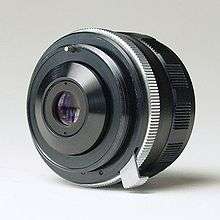

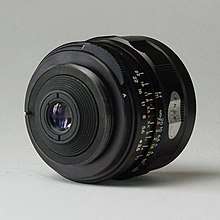
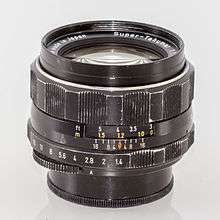
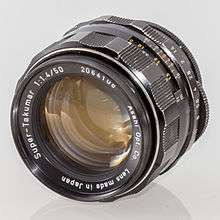
Details
The Takumar designation was used on lenses designed for Asahi's 35 mm cameras, 6×7 cameras, and for other purposes too.[3]
- Takumar lenses were made in M37 screwmount for the original Asahiflex cameras and continued into the M42 period.
- Auto-Takumar lenses were a type of preset lens. The user selected an aperture then engaged a lever to energise the stopping-down mechanism. The camera would then trip this mechanism when the shutter was fired.
- Super-Takumar lenses featured a[n improved] form of lens coating (to [reduce] flare) and a more sophisticated stopping-down mechanism. There was a switch on the lens to select "Auto" or "Manual" modes. In manual mode, the lens would always be in the selected aperture. In Auto mode, the lens would remain wide open (at maximum aperture) until a pin on the rear of the lens was pushed in. This pin would be automatically pushed in by the camera when the shutter was tripped.
- Super-Multi-Coated (later SMC) Takumar. These lenses introduced Asahi's lens multi-coating process [to further reduce reflections and flare]. They also introduced a lug on the rear of the lens which moved with the aperture selected. When used with a camera body which could read the lug, this enabled the use of open-aperture metering. Examples of such cameras are Asahi's Spotmatic F and the ES/ESII. These SMC-Takumar M42 thread mount lenses included: 15/3.5 rectilinear ultra-wide angle, 17/4 full-frame fisheye, 20/4.5, 24/3.5, 28/3.5, 35/2.8, 50/1.4, 50/4 macro, 55/1.8, 55/2, 85/1.8, 100/4 macro, 105/2.8, 135/2.5, 135/3.5, 200/4, 300/4, 400/5.6, 500/4.5, 1000/8.
The Takumar series of lenses has an excellent reputation which approaches a cult-like following among some users. They assert these are the best series of photographic lenses ever produced because:
- At the time, Japanese industry had a pride-driven, some would say fanatical dedication to producing the absolute best quality in the world.
- The lenses were designed for professional durability, quality and performance.
- Their performance especially with black and white film is extraordinary; photographs have a crisp, soulful, artistic quality usually attributed to the much more expensive West German-made Leitz and Zeiss lenses.
- The M42 thread mount (originally created by Contax, but sometimes also referred to as Pentax screw mount, or universal screw mount, or TM for thread mount) was widely used among many manufacturers and was also easily mated to other camera mounts with simple adapters, making these lenses widely used and appreciated.
- Japanese technical expertise and production quality rose rapidly to reach world-class levels in the 1970s, several years before their economy, currency and marketing ability caught up, making these lenses underrecognized and undervalued even until the present.
- Dedicated fanatics are convinced these lenses equal or surpass Zeiss lenses in every category except perhaps marketing prowess and mystique.
Pentax resurrected the Takumar name in the 1980s and 1990s for a budget line of zoom and prime lenses that lacked the Pentax "Super Multi-Coating" anti-reflective coating that reduces lens flare. These lenses are marked "Takumar (Bayonet)" or "Takumar-F" to distinguish them from the older screw-mount Takumar lenses.
Non-Asahi cameras with Asahi lenses branded Takumar include the Suzuki Press Van and two versions of the Takane Mine Six.[4]
Gallery
 Tele-Takumar 1:6.3 300 mm
Tele-Takumar 1:6.3 300 mm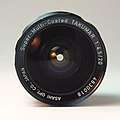 Super-Multi-Coated Takumar 1:4.5 20 mm
Super-Multi-Coated Takumar 1:4.5 20 mm Super-Multi-Coated Takumar 1:4.5 20 mm
Super-Multi-Coated Takumar 1:4.5 20 mm
References
- (in Japanese) Niimi Kahee (新見嘉兵衛), Kamera-mei no gogen sanpo (カメラ名の語源散歩, Strolls in the etymology of camera names), 2nd ed. (Tokyo: Shashin Kōgyō Shuppansha, 2002; ISBN 487956060X, p.18
- Who Was Takuma Kajiwara?; http://www.pentaxforums.com/forums/search.php?searchid=5358146
- Pentax Lens Series overview; http://www.pentaxforums.com/lensreviews/
- Suzuki Press Van: Shōwa 10–40nen kōkoku ni miru kokusan kamera no rekishi, items 795–6; (in Japanese) page on "spring cameras". Takane Mine Six: Shōwa 10–40nen kōkoku ni miru kokusan kamera no rekishi, items 1619, 1621.
- (in Japanese) Asahi Camera editorial staff. Shōwa 10–40nen kōkoku ni miru kokusan kamera no rekishi (昭和10〜40年広告にみる国産カメラの歴史, Japanese camera history as seen in advertisements, 1935–1965). Tokyo: Asahi Shinbunsha, 1994. ISBN 4-02-330312-7.
External links
| Wikimedia Commons has media related to Takumar lenses. |
- Comprehensive Pentax Screwmount (M42) Lens info
- User reviews of Takumar lenses at Pentaxforums.com